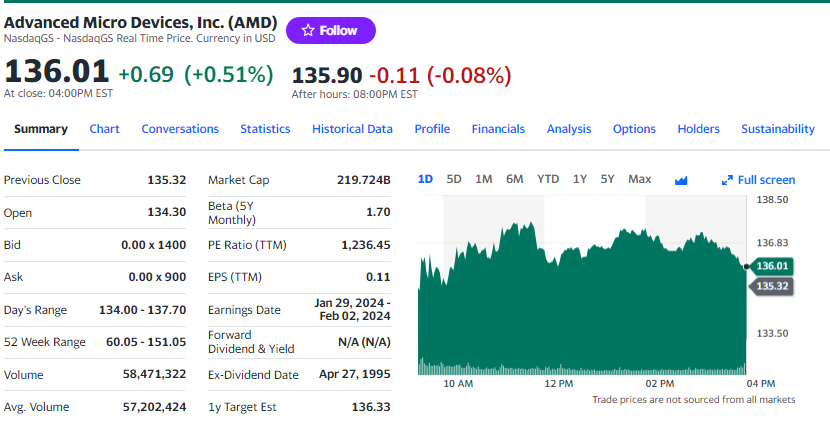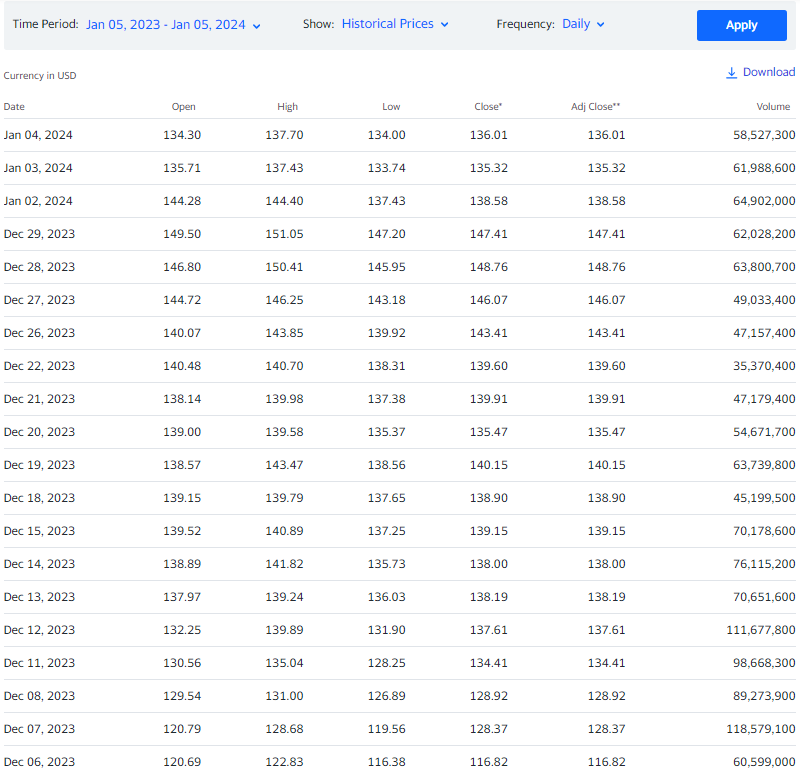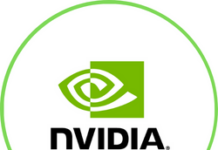This website and its content are not intended to provide professional or financial advice. The views expressed here are based solely on the writer’s opinion, research, and personal experience, and should not be taken as factual information. The author is not a financial advisor and lacks relevant certifications in that regard. We highly recommend consulting a qualified financial advisor before making any investment decisions, as the information presented on this site is general in nature and may not be tailored to individual needs or circumstances.
As of the most recent trading session, Advanced Micro Devices, Inc. (AMD) closed at a price of $136.01, marking a slight increase of 0.51% from its previous close. This price point serves as a critical starting point for analyzing AMD’s market position and stock performance.
AMD’s prominent role in the semiconductor industry, driven by its innovative CPUs and GPUs. AMD has established a strong presence in both the consumer and enterprise sectors, challenging industry norms. The success of AMD’s Ryzen and Radeon series has been pivotal in its ascent in the market, earning acclaim for performance and value. This section would highlight how AMD’s strategic product launches and competitive strategies have shaped its current status and future potential in the highly competitive tech industry.

Historical Stock Performance Analysis of AMD
Analyzing the historical stock performance of AMD reveals a dynamic and volatile journey, reflective of the broader trends in the tech industry. Over the final quarter of 2023, AMD’s stock price demonstrated notable fluctuations, indicative of both the company’s strategic moves and the market’s response to broader economic factors.
In the latter part of 2023, AMD’s stock price saw a range of movement. Starting in early November, the stock was trading around $98.58 and experienced a significant upward trend, reaching a high of $139.52 by mid-December. This period was marked by substantial trading volumes, often exceeding 70 million shares per day.
The stock’s upward trajectory in this period can be attributed to several factors, including market optimism about AMD’s strategic positioning in the semiconductor industry, its product innovations, and its competitive stance against rivals like Intel and Nvidia. Additionally, broader market trends and investor sentiment towards tech stocks likely played a role in this performance.
Notably, AMD’s stock price peaked at $139.52 on December 15, 2023, before experiencing some fluctuations but generally maintaining a strong position. This pattern reflects the company’s resilience in the face of market volatility and its ability to capitalize on strategic opportunities in the technology sector.

AMD’s Financial Highlights and Earnings Insights
AMD’s financial performance in 2023 reflects a company that is adapting and growing in the competitive tech industry. The company’s financial results across different quarters of the year reveal insights into its operational efficiency, profitability, and strategic positioning.
First Quarter of 2023:
- AMD reported a revenue of $5.4 billion, indicating strong market presence.
- The gross margin stood at 44%, showing the cost-effectiveness of their operations.
- The company faced an operating loss of $145 million and a net loss of $139 million, reflecting certain challenges in the market.
- The diluted loss per share was reported at $0.09.
Second Quarter of 2023:
- Revenue remained steady at $5.4 billion.
- The gross margin improved to 46%, signifying better profitability.
- Operating loss reduced significantly to $20 million.
- Net income was at $27 million, and the diluted earnings per share were $0.02, showing signs of recovery.
Third Quarter of 2023:
- AMD achieved a revenue of $5.8 billion, demonstrating growth.
- The gross margin further improved to 47%, and on a non-GAAP basis, it was 51%.
- Operating income was reported at $224 million, a remarkable improvement.
- Net income reached $299 million, and the diluted earnings per share were $0.18, marking a substantial turnaround in financial performance.
AMD’s Role and Impact in the Evolving Tech Industry
Advanced Micro Devices, Inc. (AMD) is a prominent force in the dynamic tech industry, particularly noted for its contributions to gaming, artificial intelligence (AI), and cloud computing. AMD’s role in these sectors is defined by strategic decisions, significant investments in research and development (R&D), and a series of innovative products that highlight its importance in the technology landscape.
Strategic Moves in Technology Sectors
AMD has been at the forefront of technological advancements in several sectors. In gaming, AMD’s graphics processing units (GPUs) and central processing units (CPUs) are highly regarded for their performance and efficiency. The company’s products are integral to powering popular gaming consoles and high-performance PCs.
In the field of AI, AMD’s EPYC processors and Radeon Instinct GPUs are increasingly adopted for AI workloads and machine learning applications. These products are designed to handle complex computations, making them ideal for AI research and development.
Cloud computing is another area where AMD has made significant inroads. The company’s processors are used in data centers by major cloud service providers, offering a blend of performance and energy efficiency that is critical for large-scale cloud operations.
R&D Investments and Product Innovations
AMD’s commitment to innovation is evident in its R&D investments. The company focuses on developing cutting-edge technologies that address current and future market needs. AMD’s introduction of the Ryzen and EPYC series processors marked a significant advancement in CPU technology, challenging the market dominance of competitors.
The acquisition of Xilinx in 2022 further augmented AMD’s capabilities, especially in adaptive computing and AI. This acquisition allows AMD to expand its product portfolio and strengthen its position in key markets.
Analysis of AMD’s Product Innovations
AMD’s product innovations reflect its strategy to offer high-performance computing solutions across a range of applications. The company’s GPUs and CPUs are known for their power efficiency, performance, and cost-effectiveness, making them a preferred choice in both consumer and enterprise markets.
Competitive Landscape: AMD vs. Industry Giants
Advanced Micro Devices, Inc. (AMD) operates in a highly competitive semiconductor industry, facing off against established giants like Intel and Nvidia. The company’s competitive landscape is shaped by its strategic positioning, market share, and growth in various sectors.
Comparison with Intel and Nvidia
- Intel, known for its dominance in the CPU market, has been AMD’s traditional rival. However, AMD has made significant inroads, especially with its Ryzen series, challenging Intel’s market share in personal computing and server processors.
- Nvidia, a leader in GPUs, particularly for gaming and AI applications, competes with AMD’s Radeon and Instinct series. While Nvidia holds a substantial market share in high-end GPUs, AMD has been closing the gap with competitive offerings that appeal to a broad range of users.
AMD’s Market Share and Growth
- AMD has seen growth in its market share across various sectors. In the CPU market, particularly in the personal computing and server segments, AMD has steadily increased its presence, attributed to the performance and efficiency of its Ryzen and EPYC processors.
- In the GPU market, AMD’s Radeon graphics cards have gained popularity, especially among gamers and in the mid-range market segment. The company’s GPUs are also becoming more prevalent in professional and data center applications.
AMD’s competitive strategy involves a mix of innovation, pricing, and targeting specific market segments. The company has focused on delivering high-performance products at competitive prices, which has allowed it to gain ground against its larger competitors. Additionally, AMD’s recent acquisitions and partnerships have further strengthened its position in the industry.
The semiconductor industry is characterized by rapid technological advancements and changing market dynamics. AMD’s ability to keep pace with these changes, combined with its strategic growth initiatives, positions it as a strong contender in the global tech landscape.
Investor Sentiment and Market Predictions for AMD
As of early 2024, investor sentiment towards AMD stock appears mixed but leans towards optimism, especially regarding its long-term prospects. The company’s performance in 2023, along with its strategic moves, have created a positive outlook among many investors.
- Strong Performance in 2023 and Positive Long-Term Outlook: AMD’s stock had a significant gain of more than 125% in 2023, driven by key developments and promising prospects in AI and other technologies. The Ryzen 8040 Series laptop processors, offering a 60% performance boost for AI applications, have positioned AMD strongly in this competitive space. Additionally, AMD’s Instinct MI300 Series accelerators are seen as major factors enabling the company to compete effectively in the AI chip field.
- New Product Launches and Strategic Collaborations: The upcoming launch of the Radeon RX 7600 XT graphics card is anticipated to further strengthen AMD’s position in the market, offering a balance between performance and pricing. This new product is expected to compete with Nvidia’s RTX 4060 and RTX 4060 Ti chips. Furthermore, AMD’s collaboration with major tech players like Meta, OpenAI, and Microsoft, particularly in adopting AMD’s latest AI chip, the Instinct MI300X, indicates a shift toward alternatives to Nvidia’s graphics processors in AI.
- Analyst Ratings and Price Targets: Analyst opinions on AMD vary, with some maintaining positive ratings and raising price targets, while others express caution due to near-term market uncertainties. For example, Susquehanna Financial Group reiterated a Positive rating and raised the price target from $135 to $145. However, there’s a general consensus on the company’s long-term potential, especially in AI.
- Challenges and Competitive Landscape: While the near-term outlook for AMD has been affected by broader market downturns and downgrades, the company’s strategic pricing and performance advantages in AI chips provide a strong foundation for future growth. AMD’s competition with Nvidia in data center and AI segments remains a key area to watch.
In essence, AMD’s stock outlook for 2024 is influenced by its recent performance, innovative product launches, strategic partnerships, and the company’s growing presence in the AI segment. Despite some near-term challenges, the long-term prospects for AMD appear promising, driven by its competitive strategies and technological advancements.
FAQs: Understanding AMD’s Stock Viability
Investors and market analysts frequently discuss various aspects of AMD’s stock, focusing on its growth potential, challenges, and comparison with competitors. Here are some common questions and insights based on current market analysis and expert opinions:
AMD has positioned itself as a strong contender against Nvidia, especially in the AI accelerator market with its MI300 line of chips. Although Nvidia currently leads with a significant market share, AMD’s products are gaining traction with major clients like Meta Platforms, OpenAI, and Microsoft. This competition is healthy for the market and provides a robust choice for consumers and investors.
AMD’s AI chips, particularly the MI300 family, are expected to supercharge the company’s growth. These chips are positioned to compete effectively with Nvidia’s h100 in AI applications. The AI chip market is rapidly expanding, and AMD’s entry into this segment is timely and strategic. The company’s success in securing big-name clients for its AI chips indicates strong market confidence in their performance and potential.
While AMD’s AI business is a focal point of its growth strategy, its legacy operations related to consumer and enterprise processors and graphics remain crucial. Despite challenges faced in 2022, including a slowdown in PC sales and geopolitical tensions, AMD’s client segment has shown recovery, driven by the popularity of its Ryzen 7000 processors.
AMD’s stock trades at a significant multiple of its earnings, which some investors may view as steep. However, the company’s growth potential, especially in the AI accelerator market, supports this valuation. AMD’s expansion of its addressable market forecast to $400 billion by 2027 reflects its optimistic growth trajectory.
Analysts have mixed views but are generally bullish about AMD’s performance in 2024. The company is expected to hit new highs, backed by strong product launches and a growing presence in the AI market. The technical outlook for AMD’s stock is favorable, with predictions of reaching new resistance levels in the coming year.
Conclusion
Evaluating AMD’s future in the tech market involves understanding its current position, recent strides in technology, and the challenges it faces. AMD has established itself as a key player in the semiconductor industry, with significant advancements and a strong presence in high-growth areas like AI, cloud computing, and gaming. Its focus on innovative products, such as the MI300 chip series and the Ryzen 7000 processors, showcases its commitment to maintaining a competitive edge.
However, AMD operates in a dynamic and challenging environment, marked by intense competition and rapid technological changes. The company’s ability to navigate these challenges, adapt to evolving market needs, and leverage opportunities in emerging tech sectors will be crucial for its long-term success.
In summary, AMD’s future looks promising, supported by its strategic positioning, technological advancements, and potential to capitalize on global trends in advanced computing. Its ability to innovate and adapt will be key in maintaining its competitiveness in the fast-paced tech industry. The company’s journey so far indicates not just survival but a thriving presence amid the complexities of the global tech landscape, with bright prospects for continued growth and market leadership.
StockHax strives to provide unbiased and reliable information on cryptocurrency, finance, trading, and stocks. However, we cannot provide financial advice and urge users to do their own research and due diligence.
Read More


